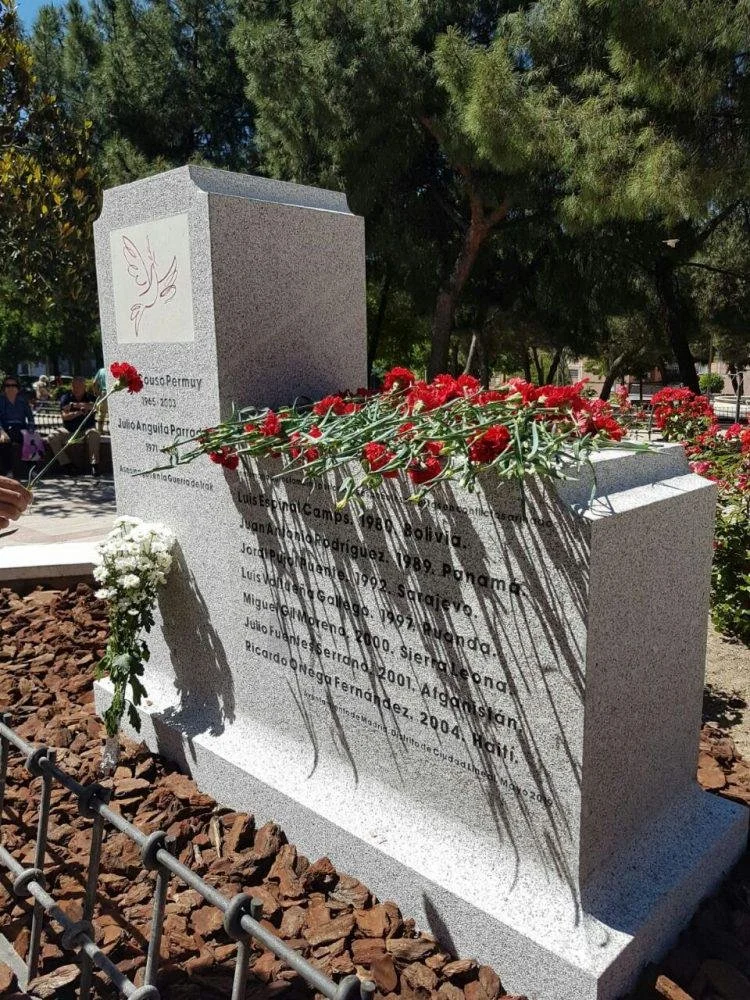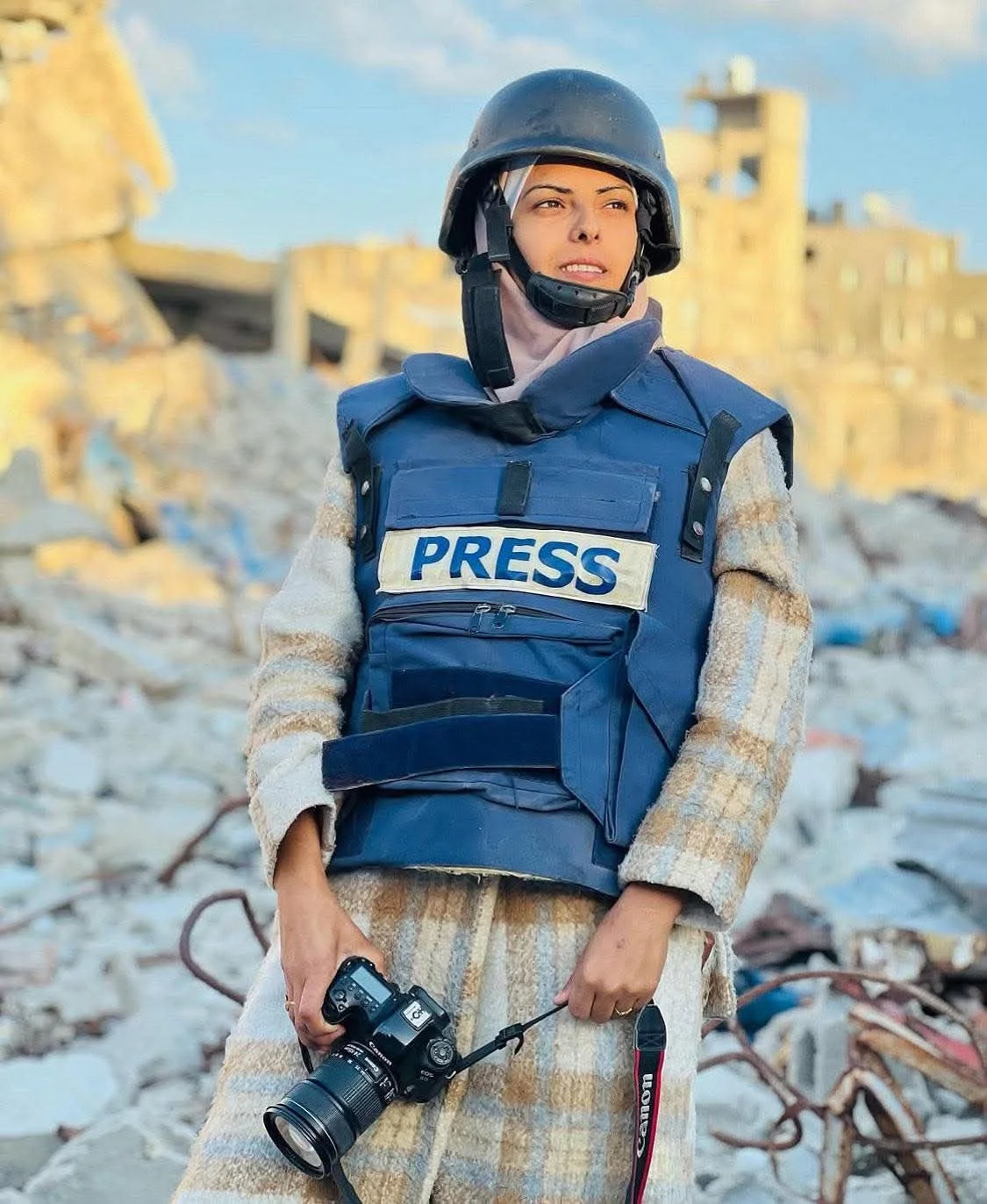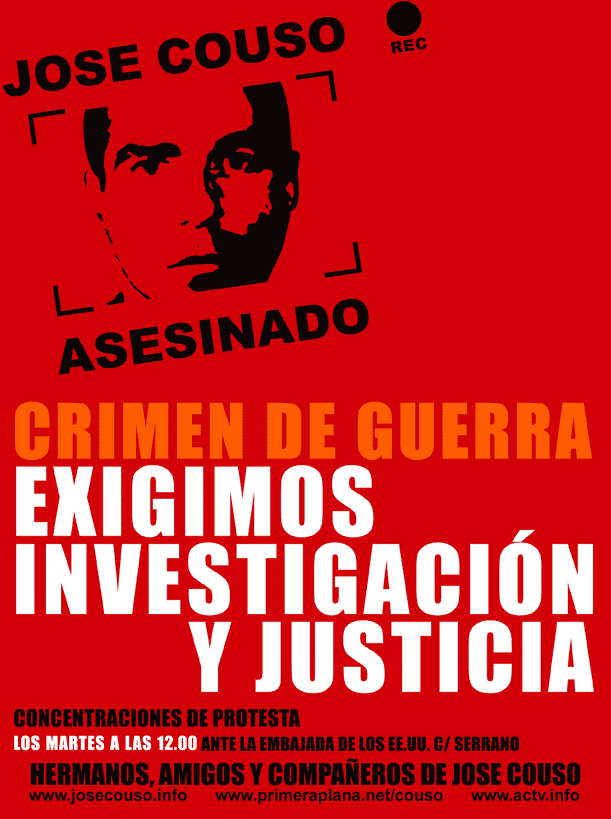Israel’s Killing of Journalists in Gaza Echoes US Invasion of Baghdad
Monument to Spanish journalists killed in armed conflicts, inaugurated in 2019 in Ciudad Lineal (a district of Madrid, Spain) as part of the “José Couso Permuy and Julio Anguita Parrado Garden” named for two Spanish journalists killed in Iraq. (Diario de Madrid, CC BY 4.0, via Wikimedia Commons)
Hussam al-Masri, Mariam Abu Dagga, Mohammed Salam, Moaz Abu Taha,, and Ahmad Abu Aziz: Israeli airstrikes on the Nasser Hospital in southern Gaza on Monday reportedly killed these five Palestinian journalists as well as at least fifteen other Palestinians. The attack on those who bear witness to events on the ground occurred precisely as Israel is threatening to begin a major plan to occupy Gaza City.
Al Jazeera reported that the latest Israeli attack was a so-called “double-tap strike,” with a second missile hitting the hospital “as rescue crews arrived” following an earlier missile strike on the same location. Double-tap strikes have played a key role in Israel’s military assault on Gaza, mirroring actions allegedly taken by other major powers such as the United States and Russia. +972 Magazine reporter Yuval Abraham noted that while such strikes are “widely considered illegal under international law,” the Israeli military has nonetheless “adopted the practice…as standard procedure in Gaza.”
Palestinian photojournalist Maryam Abu Daqqa was one of the five journalists killed in the Israeli strike on Nasser Hospital.
Reuters reported that al-Masri, a cameraman and Reuters contractor, was killed by the first missile. The live video feed that he operated went offline at that moment. As the other four journalists arrived on the scene, presumably to aid their colleague, the Israeli military fired the second missile into the building.
Unpunished crimes, from Baghdad to Gaza
Meanwhile, the horrifying details of Monday’s Israeli attack on Nasser Hospital also trigger traumatic memories of the early days of the US invasion of Iraq in 2003. On the morning of April 8, 2003, US forces fired on three different media locations in Baghdad. A US missile attack on the headquarters of Al Jazeera killed reporter Tareq Ayyoub and wounded one of his cameramen. Another strike on the office of Abu Dhabi TV injured two journalists.
Olga Rodriguez social media post about José Couso. (Instagram, April 8, 2023)
On the same day, a US tank fired shells at the Palestine Hotel, where many international journalists were staying. Two journalists, José Couso of the Spanish network Telecinco, and Tarak Protsyuk of Reuters, were killed. And just as at the Nasser Hospital in Gaza in 2025, the live feed that Reuters was providing at a key moment in a major, developing story - a feed that sent images to viewers throughout the world - instantly went dark.
Such memories are especially resonant in Spain, where repeated efforts to hold US troops - or others further up the chain of command - accountable for Couso’s death have run up against a brick wall of US impunity, whether in the Spanish or broader European legal context.
Olga Rodriguez, who now reports for the Spanish outlet El Diario and who is one of the country’s most important and committed voices on human rights in Palestine and elsewhere, was in Baghdad when the US attacks took place. In a 2023 social media post written to commemorate the twentieth anniversary of Couso’s death, she spoke directly to the intensity and horror of those events and their broader significance:
In the following hours, we had to focus on our wounded, cry for our dead, and figure out alternative security arrangements. There are no images showing what happened in Baghdad during those hours. The next day, the US troops occupied the center of the city.
The US justified its attack saying that they had seen a “spotter,” someone with binoculars. All of us were “spotters,” the US tanks could be seen from most of the buildings in central Baghdad. A “spotter” isn’t someone armed, nor do they pose a threat. Firing on a place full of civilians is a war crime.
There has been no justice for Couso. To condemn his murder is to defend freedom of information and the international laws that protect civilians and journalists during armed conflict.
I witnessed that, and I will never forget it.
Couso’s mother, Maribel Permuy, spent the rest of her life fighting for justice for her son. According to Rodriguez, Permuy ultimately said that she felt “used” by politicians who reneged on promises to help hold someone responsible. She also offered words that speak directly to the current moment when journalists are being assassinated in Gaza. “If a war crime is allowed to go unpunished,” she said, “we will be laying the groundwork for more and greater abuses in the future.”
Poster demanding investigation and justice for the murder of Spanish cameraman José Couso in Iraq. (CNT Valladolid, CC BY-SA 2.0, via Wikimedia Commons)
The responsibility of journalism in “extreme times”
Israel’s killing of more than 200 journalists and media workers in Gaza has come under growing international condemnation, particularly after well-known Al Jazeera reporter Anas el-Sharif and five other journalists were assassinated on August 10 in what the Committee to Protect Journalists (CPJ) called “a targeted strike on a tent used by media near Al-Shifa Hospital in Gaza City.” Three days later, the CPJ’s CEO, Jodie Ginsberg, pointedly accused Israel of “wiping out Gaza’s journalists [and] no longer even hiding it.”
Palestinians themselves, of course, have been begging the world to pay attention long before such op-eds began to trickle out.
Moreover, recent analysis from the media watchdog organization FAIR suggests that Western establishment media have, at worst, played an active role in “manufacturing consent” for Israel’s murder of journalists in Gaza. According to FAIR analyst Emma Lucia Llano, major outlets including CNN, the New York Times, Politico, and the AP covered the killing of el-Sharif and his colleagues in ways that “overwhelmingly centered Israel’s narrative, attempted to delegitimize pro-Palestinian sources, and failed to contextualize the killings within the larger context of the genocide.”
What is the responsibility of journalists and news organizations in the face of Israel’s apocalyptic assault on Gaza, including its attacks on journalists themselves? Noting what it described as a “muted” response from many journalism organizations, the influential Columbia Journalism Review (CJR) recently admitted that many journalists and news consumers “have come to view this, ultimately, as a failure to contend with man-made human catastrophe in Gaza, including for reporters—and it has marked a breaking point in their relationships with legacy news institutions.”
With this in mind, the CPJ reached out to “thinkers from across the fields of journalism, human rights, literature, academia, and advocacy,” asking them to offer new ideas for defending press freedom in Gaza.
The CPJ highlighted the perspective of Al Jazeera’s Youmna ElSayed, who wrote, “The fact that news organizations are not willing to take the risk to enter Gaza is an implicit acknowledgment of the reality that it isn’t a safe place to be and that journalists are not protected there—and yet those same news organizations are not acknowledging that reality directly, openly, and reporting about the way it is.” ElSayed emphasized that mere “verbal condemnation” is fundamentally insufficient, insisting that news organizations should be pushing for international sanctions on Israel.
Other responses included:
Sharif Abdel Kouddous of Drop Site News called for strong labor action: “Journalists in Western newsrooms could strike. They could refuse to work until some sort of substantive demand for a policy change at these institutions is fulfilled…Perhaps it could be an open-ended strike in solidarity with Palestinian journalists.”
Former CNN correspondent Arwa Damon floated the idea of “banning Israeli government and military voices from air and print until they let the press into Gaza,” an idea which would directly address the ideological bias identified in FAIR’s analysis.
International correspondent and filmmaker Hind Hassan called for a coordinated and dramatic effort to put these issues in front of the public: “[N]ews organizations could coordinate a one-hour global media pause across print, broadcast, and digital platforms. During this hour, regular programming or content would be replaced by a unified message such as ‘Journalism is not a crime,’ along with information on journalists killed in Gaza and international journalists’ lack of access to the Strip. Media platforms would display a blackout screen or a full-page message during the campaign. Newspapers could use a blackout front page or banner.”
Investigative journalist Nick Turse suggested that in “extreme times,” journalists should take a page from the book of activists and consider forms of “direct action” such as “a flotilla, a march, a convoy, or just trying to breach the border.”
Many of these ideas echo the words of Rodriguez, the Spanish journalist for El Diario, who has been tirelessly calling for concrete measures to hold Israel accountable and to address the desperate suffering of Palestinians in Gaza. She outlined these measures systematically in an August 2 article addressing the responsibility of governments, international organizations, and civil society. She invoked the need for economic sanctions, a military and commercial embargo, diplomatic isolation, bringing legal charges against Israeli officials under international law, sending aid flotillas to break the Israeli siege of Gaza, and using all available platforms and networks to denounce the genocide, promote solidarity, and demand justice for Palestinians.
What remains to be seen is how many other Western journalists will have the courage to follow Rodriguez’s example.





